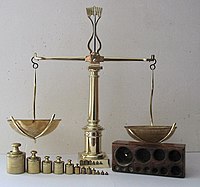
Photo from wikipedia
Commercial hemodialyzers are hollow-fiber cylindrical modules with dimensions and inlet–outlet configurations dictated mostly by practice. However, alternative configurations are possible, and one may ask how they would behave in terms… Click to show full abstract
Commercial hemodialyzers are hollow-fiber cylindrical modules with dimensions and inlet–outlet configurations dictated mostly by practice. However, alternative configurations are possible, and one may ask how they would behave in terms of performance. In principle, it would be possible to depart from the standard counter-flow design, while still keeping high clearance values, thanks to the increase in the shell-side Sherwood number (Sh) due to the cross-flow. To elucidate these aspects, a previously developed computational model was used in which blood and dialysate are treated as flowing through two interpenetrating porous media. Measured Darcy permeabilities and mass transfer coefficients derived from theoretical arguments and CFD simulations conducted at unit-cell scale were used. Blood and dialysate were alternately simulated via an iterative strategy, while appropriate source terms accounted for water and solute exchanges. Several module configurations sharing the same membrane area, but differing in overall geometry and inlet–outlet arrangement, were simulated, including a commercial unit. Although the shell-side Sherwood number increased in almost all the alternative configurations (from 14 to 25 in the best case), none of them outperformed in terms of clearance the commercial one, approaching the latter (257 vs. 255 mL/min) only in the best case. These findings confirmed the effectiveness of the established commercial module design for the currently available membrane properties.
Journal Title: Membranes
Year Published: 2022
Link to full text (if available)
Share on Social Media: Sign Up to like & get
recommendations!